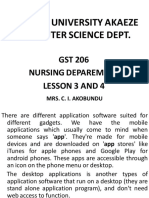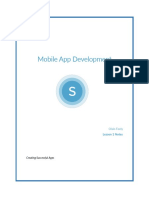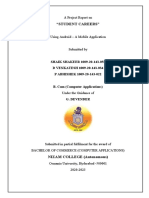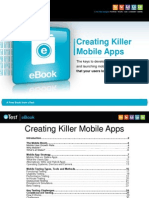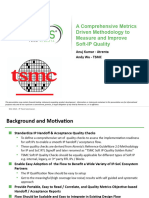Graphic Design
Design on the
Go
Summary Notes
�Contents
3 Lesson outcomes
3 Introduction
4 The advent of mobile applications
6 Did you know?
6 Mobile vs Desktop
7 Mobile apps for graphic design
11 References
GRAPHIC DESIGN
� Lesson outcomes
By the end of this lesson, you should be able to:
• Understand the advent of mobile applications
• List and identify mobile apps for graphic design
• Design with mobile apps
Introduction
Even though technology has changed vastly, especially over the last decade or so, mobile applications are not yet where
computers are, especially when it comes to creating custom designs. There are a variety of mobile apps that make it
possible to create amazing looking designs however.
These applications work on the principle of having pre-set templates that can be adjusted accordingly. And even though
these apps do not really count as claiming yourself to be a professional graphic designer, it is crucial to know about them
and their features because, even graphic designers need to design on the go, when they don’t have their computers with
them.
Perhaps in the future, graphic design might change to be more mobile-based, but for the time being, a computer still
allows you the most flexibility and control when it comes to graphic design and I personally, prefer a computer. I still
believe you need a solid foundation, a thorough understanding of the elements & principles of design as well as experience
to even consider yourself a professional, regardless of the medium you use.
Like it or hate it, graphic design is changing, and we need to adapt with the times!
Susan Kare, famous for her interface icons, typeface contributions and also one of the first employees of NeXT, the IT
company established by Steve Jobs, stated that “good design’s not about what medium you’re working in. It’s about
thinking hard about what you want to do and what you have to work with before you start.
I will be showing you the use of design applications on mobile phones today. You might have heard of these applications
before or not. Either way, one thing is certain: never underestimate the medium you’re working on. You won’t go to a
bakery claiming they have the best oven that bakes the most amazing cakes, no, you would rather complement the baker,
of course! The same principle applies to design – it’s not the medium or application you use that makes a design
successful, it is the designer!
GRAPHIC DESIGN
�The advent of mobile applications
The origin of mobile phones
Mobile apps have been around for a lot longer than we might think. Not necessarily in the sense we understand an app to
be but none the less, they have been around since 1993!
To understand where mobile apps fit into this whole picture, we need to look at some history. I would like to start with the
first mobile phone which was created by Motorola.
The first mobile phone invented by Motorola
This phone made the first call in 1973! It weighed a whopping 1,1kg – this is equivalent to 2,4 pounds! However, another
decade had to pass before you could actually buy a mobile phone for a monstrous price of $4000!
GRAPHIC DESIGN
�The origin of smartphones
The evolution of the cellular phone led to the invention of the smart phone in 1992 – the first smart phone was known as
the Simon Personal Computer. It was however only available commercially in 1994.
The Simon Personal Computer, first smartphone
What is the difference between a cellular phone and smart phone? The features that differentiated this device from mobile
phones was the fact that it had a touch screen, could send and receive emails and faxes, and it had a notes and calendar
function. The Simon Personal computer had a monochrome LCD display and its battery only lasted for one hour.
What is a mobile app?
A mobile app or application is a software application designed to be used on small, wireless computing devices like
smartphones and tablets including iOS and Android. It is thus a computer software or program in a compact format rather
considering the demands and constraints of said devices.
Understanding that it works with the device’s constraints in mind, it is then obvious that mobile apps are not as functional
as their computer equivalents.
Mobile apps do however offer amazing features that computers might not offer due to the fact that they are compatible
with mobile devices. Thinking specifically with regards to your GPS on your phone. This application is able to take you
anywhere you desire with live updates of roadblocks or speed cameras. At the end, the aim of a mobile app is to make the
lives more convenient and easier for its operator.
GRAPHIC DESIGN
� Did you know?
Did you know that your mobile phone has more computing power than the computer used for the Apollo 11 moon
landing?
The Apollo computer had a miniscule 32 768 bits of RAM memory! If this does not make much sense to you, let’s
compare it to your phone. The typical mobile phone today has around 4gb of ram which is roughly 34 billion RAM
compared to the 32 000 RAM from Apollo 11’s computer! Even comparing the Apollo 11 computer to a current classic
calculator, our classic calculator is 140 times faster!
Mobile vs Desktop
Apple launched its App store back in 2008 and we did not realise how ground-breaking this would be. Several years later,
anyone, whether you have an iPhone or Android phone can access the App or Play store respectively and download almost
any app imaginable. What ever you can think of, there will probably be an app for that.
Now considering that mobile apps are here to stay, desktop software is far from dead and for good reason.
Mobile devices and apps
Let’s look at the features that differentiate a mobile app from desktop software, and although it feels almost impossible to
live without mobile apps, they do have their shortcomings.
Good Not so good
• Firstly, it is extremely easy to use. • Apps are also one-purpose. Meaning that you have an app for
I don’t think I even need to every task that you would like to do. This means that you will
elaborate on this – if you have probably install a lot of apps for all your tasks
used apps before, you will know • Due to mobile phones and tables small scale, apps have limited
what I mean. They are simply functionality
intuitive, and this makes them • Even though mobile phones and tables processors are
quick to get used to. improving, they are still weak in comparison to desktop
• If you have an internet computers
connection, you can download an • Storage space on your phone is also not as vast as on your
app wherever you are computer
• Mobile apps are normally free to • When a desktop software or website is converted to a mobile
use, but you might get in-app app, it is difficult to replicate the user interaction to match that
purchases of the desktop software or website.
GRAPHIC DESIGN
�On the other hand, desktop software has been around for a lot longer.
Good Not so good
• The fact that you do not necessarily need to have • The problem with computers is that most
internet access to make a desktop app work is a massive software is not free, however, there are
advantage. plenty of open source software that has
• Computers have greater functionality with the software amazing capabilities but in general the
installed on them. good stuff aren’t free.
• Computers in general have faster processors than • Computers, whether it be a desktop or
mobile devices like smart phones and tablets, which laptop are bulkier and thus you can’t
makes them powerful machines. always carry them around with you – this
• Desktop computers have more storage space than your limits their range of accessibility.
mobile phone. • I do believe in future this will change, I
• It is relatively easy to upgrade your hardware on a mean, it is currently changing, and today’s
computer – you simply add more RAM or a bigger hard mobile phones are a lot more advanced
drive whereas with mobile devices, you need to upgrade than 5 years ago. But for the time being,
to a later model. desktop software just allows you more
• Computers are quite durable and lasts a lot longer than flexibility and functionality when it comes
mobile devices to graphic design specifically
Mobile apps for graphic design
Now, before you accuse me of anything, I want you to look at these applications with an open mind. Reiterating Susan
Kare’s quote – it’s not about the medium but about the thought and effort behind the project. I myself was quite against
these applications because I thought you don’t need to think much to create a design but using the knowledge, skills and
foundation you have learnt and build up in this course up to know, I am sure you will be able to make good judgement
about the designs you are creating. Also, having these applications to your access, you should be a lot better than your
cousin who downloaded these apps but don’t have a design background.
Having a better understanding on mobile apps, their role and limitations, we will investigate some useful apps that
graphic designers can make use of aiding them in making life slightly easier.
Mobile apps for graphic design
I have hand picked the following apps but am sure that there are other amazing and useful apps that make our lives as
graphic designers a lot easier. The problem is that there are so many apps to choose from, so where do you start? If you
have any other interesting apps that you make use of, then by all means, keep using them!
Canva is the first app we will look at today.
Canva
You can select a template for which ever reason, whether you are creating an Instagram story or post, a logo, a flyer,
video… basically any design you can think of. But due to the fact that it is template based, makes your designs slightly
more generic looking. You can however create a nice design on the desktop version and you will still be able to access it
GRAPHIC DESIGN
�on your smart phone. Also, you can actually start from scratch and open a blank document. Canva is free to use but have
paid-for features.
Adobe Capture is handy for when you want a specific colour scheme or palette form a photograph in your phone’s library
or of a photo that you are about to take.
Adobe Capture
What is amazing about this app is that it syncs to all your other adobe applications. It has the ability to identify fonts,
create looks, colour schemes, patterns and even brushes that can be used in for example Adobe Photoshop.
Spark Post, is also an Adobe product and does the same thing as Canva – you have a variety of templates to choose from in
order to create amazing designs ranging from Facebook posts, invitation cards, videos and what ever you can think of.
Adobe Spark Post
A lot of the templates are free, but you also get paid-for templates. As with Canva, you can also create a design from
scratch here.
Resplash is just a really cool app version of the already popular Unsplash website where you are able to access millions of
amazing quality stock images for your designs.
Resplash
You are also able to access stock photos from Canva and Spark Post but you will never have enough options when it comes
to accessing good quality photos. Most of the images I used in this lesson’s design I got from Unsplash.
GRAPHIC DESIGN
�Canva demo (please refer to video lesson)
I will give you a demo of each of the 4 applications I introduced to you earlier. Note that I won’t do a design in each
application but will mainly introduce you to the interface of these apps. Since they are intuitive and extremely user
friendly, I don’t think you will have an issue when it comes to creating awesome designs with these apps. Lets start with
Canva… which is an all-in-one graphic design app allowing you to create almost any type of design, from a Facebook post,
to a video.
Demo in Canva
Adobe Capture demo (please refer to video lesson)
Imagine that you can use your phones camera to see vectors, patterns and even fonts. Adobe capture allows you to create
vectors, colour palettes, patterns, 3D material from your camera and photos and you can even import them into your
favourite Adobe desktop software!
Adobe Capture demo
GRAPHIC DESIGN
�Spark Post demo (please refer to video lesson)
Like Canva, Adobe Spark Post makes mainly use of professionally designed templates that you can tweak and adjust to
suit your specific needs. You will be able to create animated video posts, invitations, photo collages, memes, flyers and a
whole lot more.
Spark Post demo
Resplash demo (please refer to video lesson)
Resplash offers its user access to millions of free professionally taken photographs from around the world. Thank you to
all these photographers allowing use to make use of your work! By the way, most of the stock images in this lesson is from
Unsplash, which is the web version of Resplash.
Resplash demo
GRAPHIC DESIGN
�Conclusion
Although apps are limited in comparison to desktop or web-based software, there is a space and a place for them in our
current society and lifestyle. They literally make life slightly easier for us and seeing as they won’t disappear in the near
future, we might as well utilise these features.
References
• 360 Logica, n.d., Mobile Apps vs Desktop Apps – A deeper look!, Accessed from
https://www.360logica.com/blog/mobile-apps-vs-desktop-apps-a-deeper-look/
• Aamoth, D., 2014, First Smartphone Turns 20: Fun Facts About Simon, Accessed from
https://time.com/3137005/first-smartphone-ibm-simon/
• Andrew, O., 2018, The History and Evolution of the Smartphone: 1992-2018, Accessed from
http://www.crownconnect.com/offset-printing/
• Jamsheer K, 2019, The history and evolution of mobile apps, Accessed from
https://acodez.in/evolution-mobile-apps/
• Kel, H., 2019, 15 Tools And Apps Every Graphic Designer Should Have In 2020, Accessed from
https://www.designhill.com/design-blog/tools-and-apps-every-graphic-designer-should-have/
• Kendall, G., 2019, Your Mobile Phone vs. Apollo 11’s Guidance Computer, Accessed from
https://www.realclearscience.com/articles/2019/07/02/your_mobile_phone_vs_apollo_11s_guidance_
computer_111026.html
• Kennedy, P., 2013, Who Made That Cellphone?, Accessed from
https://www.nytimes.com/2013/03/17/magazine/who-made-that-cellphone.html
• Rouse, M., 2013, mobile app, Accessed from https://whatis.techtarget.com/definition/mobile-app
GRAPHIC DESIGN






